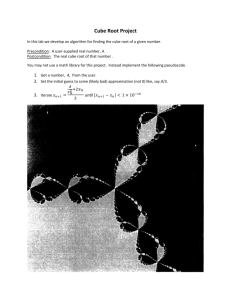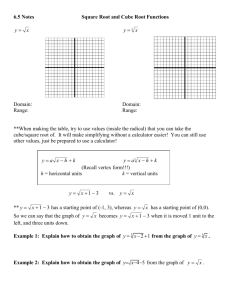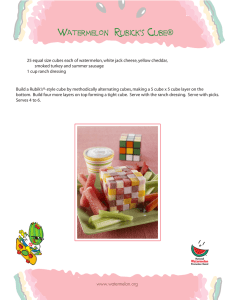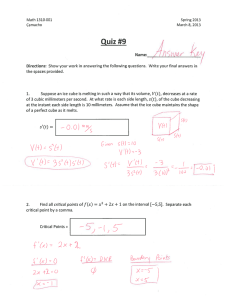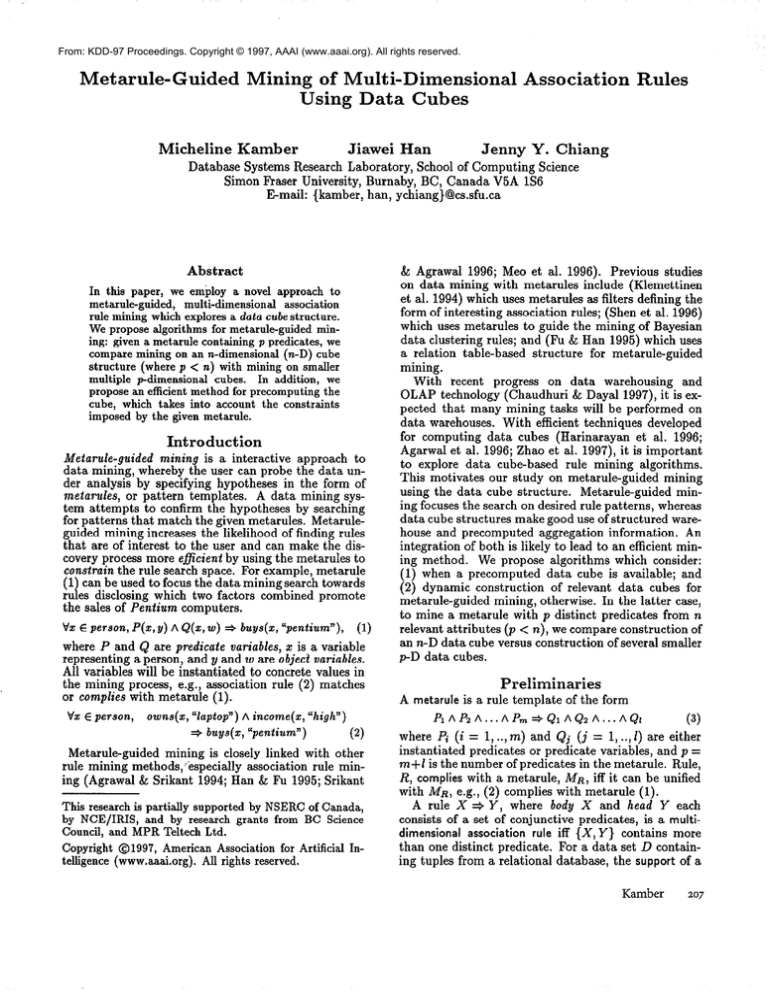
From: KDD-97 Proceedings. Copyright © 1997, AAAI (www.aaai.org). All rights reserved.
Metarule-Guided
Mining of Multi-Dimensional
Using Data Cubes
Micheline Kamber
Jiawei Han
Association
Rules
Jenny Y. Chiang
Database Systems Hesearch Laboratory,
School of Computing
Science
Simon Fraser University, Burnaby, BC, Canada V5A lS6
E-mail: {kamber, han, ychiang}@cs.sfu.ca
Abstract
In this paper, we employ a novel approach to
metarule-guided,
multi-dimensional
association
rule mining which explores a data cube structure.
We propose algorithms for metarule-guided
mining: given a metarule containing p predicates, we
compare mining on an n-dimensional (n-D) cube
structure (where p < n) with mining on smaller
multiple pdimensional
cubes. In addition, we
propose an efficient method for precomputing the
cube, which takes into account the constraints
imposed by the given metarule.
Introduction
Metarule-guided mining is a interactive
approach to
data mining, whereby the user can probe the data under analysis by specifying hypotheses
in the form of
metarules, or pattern
templates.
A data mining system attempts
to confirm the hypotheses
by searching
for patterns that match the given metarules.
Metaruleguided mining increases the likelihood of finding rules
that are of interest to the user and can make the discovery process more eficient by using the metarules to
constrain the rule search space. For example, metarule
(1 can be used to focus the data mining search towards
ru 1es disclosing which two factors combined promote
the sales of Pentium computers.
Vx E person, P(x, y) A Q(x, ‘w) j
buys(x, “pent&m”),
(1)
where P and Q are predicate variables, x is a variable
representing
a person, and y and w are objec2 variables.
All variables will be instantiated
to concrete values in
the mining process, e.g., association
rule (2) matches
or complies with metarule
(1).
Vx E person,
ou1ns(x, “laptops) A income(x, “high”)
=+ buys(s, “pentium”)
(2)
Metarule-guided
mining is closely linked with other
rule mining methods,Jespecially
association
rule mining (Agrawal & Srikant 1994; Han & Fu 1995; Srikant
This research is partially supported by NSERC of Canada,
by NCE/IRIS, and by research grants from BC Science
Council,
and MPR Teltech Ltd.
Copyright 01997, American Association for Artificial
telligence (www.aaai.org).
All rights reserved.
In-
& Agrawal 1996; Meo et al. 1996). Previous studies
on data mining with metarules
include (Klemettinen
et al. 1994) which uses metarules as filters defining the
form of interesting
association
rules; (Shen et al. 1996)
which uses metarules
to guide the mining of Bayesian
data clustering rules; and (Fu & Han 1995) which uses
a relation table-based
structure
for metarule-guided
mining.
With recent
progress
on data warehousing
and
OLAP technology (Chaudhuri
& Dayal 1997), it is expected that many mining tasks will be performed
on
data warehouses.
With efficient techniques
developed
for computing
data cubes (Harinarayan
et al. 1996;
Agarwal et al. 1996; Zhao et al. 1997), it is important
to explore data cube-based
rule mining algorithms.
This motivates
our study on metarule-guided
mining
using the data cube structure.
Metarule-guided
mining focuses the search on desired rule patterns,
whereas
data cube structures make good use of structured
warehouse and precomputed
aggregation
information.
An
integration
of both is likely to lead to an efficient mining method.
We propose algorithms
which consider:
(1) when a precomputed
data cube is available;
and
(2) dynamic construction
of relevant data cubes for
metarule-guided
mining, otherwise.
In the latter case,
to mine a metarule
with p distinct predicates
from n
relevant attributes
(p < n), we compare construction
of
an n-D data cube versus construction
of several smaller
p-D data cubes.
A metarule
Preliminaries
is a rule template of the form
A A Pz A... Ai’,n=kQlAQzA...AC&
(3)
where Pi (i = 1, .., m) and Qj (j = 1, .., 1) are either
instantiated
predicates or predicate variables, and p =
m+l is the number of predicates in the metarule.
Rule,
R, complies with a metarule,
MR, iff it can be unified
with MR, e.g., (2) complies with metarule (1).
A rule X + Y, where body X and head Y each
consists of a set of conjunctive
predicates,
is a multidimensional association rule iff {X, Y) contains
more
than one distinct predicate.
For a data set D containing tuples from a relational
database, the support of a
Kamber
207
mensions).
The (n-1)-D space consists of the sum cells
storing the count information
for each (n-1,LD combination of the dimensions,
and so on. The O-D space
consists of one sum cell which stores the total number of counts (or generalized tuples) represented in the
cube. A 3-D data cube is shown in Fig. 1. For sparse
cubes, sparse matrix technology (Zhao et al. 1997) can
be applied.
Figure
1: A 3-D data
cube with summary
layers
rule X 3 Y in D is the probability that the tuples in
D contain both X and Y. The confidence of X + Y
is the probability that a tuple contains Y given that it
contains X. Typically, rules that do not satisfy user- or
expert-provided
minimum support and minimum
confidence thresholds are considered uninteresting.
A kpredicate set (i.e., containing
k conjunctive
predicates)
is large if its support is no less than the minimum
support threshold.
Rule X =% Y is strong if it satis-
fies both minimum
support and minimum
confidence
thresholds.
A rule in which all the predicates
have
distinct predicate names is called a non-repetitive predicate multi-dimensional
association rule. Our study of
metarule-guided
mining of strong, multi-dimensional
association
rules is confined to this case.
Example
1 Suppose a user wishes to mine a set of strong
rules in a university database, associating the students’
gpa with their major, student-id, birth-place, and residence.
The task can be expressed in a data mining query language,
DMQL (Han & Fu 1995), as follows.
mine multi-dimensional association rules
from student
in relevance to major, student-id, birth-place, residence
set template P(s : student, z) A Q(s, y) +- gpa(s, 2).
with min-support = 0.20, min-confidence = 0.80
First, the task-relevant data is extracted, i.e., the set of
student records is projected onto {gpa, major, student-id,
birth-place, residence} using an SQL&query transformed
from the provided query. The minimum support threshold
is used to perform dimension reduction, i.e., removing attributes with too many distinct values, such as student-id,
and perform necessary generalization/discretization,
e.g.,
replacing raw data values, such as 3.873 for gpa, by higher
level concepts, such as “escellentn. This leaves only three
attributes major, birth-place, residence for possible match0
ing with the predicates, P and Q.
Our study explores rule mining using a data cube
structure.
An n-dimensional data cube, C[Al, . . . , A,],
stores the group-by aggregation
(count) of all possible
Ar.
combinations
of the n attributes
or dimensions,
Each dimension
contains lAi[ data rows (where IAil is
the number of distinct values in Ai) and one sum row,
used to store the count summation of the corresponding columns of the above data rows. A data cube can
be viewed as a lattice of cuboids. The n-D space or n-D
layer (the base cuboid) consists of all data cells (i.e., the
count
information
208
KDD-97
for each n-D combination
of the di-
Methods,
for Metarule-Guided
Using Data Cubes
Mining
In our notation,
metarule MR is in conjunctive
normal
form as in Eq. (3); p is the number of instantiated
predicates or predicate variables in MR (p 2 n, where
n is the dimension
of the cube); Lk is the set of large
k-predicate sets, and each member of Lk has two fields,
predicate set and support count; and R is the set of all
strong association
rules that comply with MR.
Mining
on
an
existing
data cube
Owing to the wide availability
of data warehouses,
a
precomputed
n-D data cube (including
the summary
layers) may be available for metarule-guided
mining.
We examine two cube-based
algorithms
for this case:
(1) multi-D-slicing, which finds large l-predicate
sets
and uses them to perform multi-dimensional
slicing
on the data cube.
This algorithm
adopts the spirit
of table-based
approaches
to association
rule mining
(such as Apriori of Agrawal & Srikant 1994) as well as
our earlier table-based
study on metarule-guided
mining (Fu & Han 1995), although here a data cube structure is used; and (2) n-D cube search, which directly
examines the p-D cells of the precomputed
n-D cube
in order to find large p-predicate
sets, L, .
Algorithm
1 (multi-D-slicing)
A
dimensional slicing technique for metarule-guided
of multi-dimensional association rules.
multimining
Input: (1) Metarule, MR, containing p distinct predicates;
(2) An n-D data cube, C[&, .., An], with all of its dimension space precomputed (p < n), where the cube contains the dimensions relevant to answering the specified
metarule query; (3) min_sup and min_conf thresholds.
Output:
R, the set of strong association rules that comply
with MR.
Method:
First find the large l-predicate sets in each dimension and then use the large predicate sets in dimension (k - 1) to grow large k-predicate sets by multidimensional slicing on the data cube until large p
predicate sets are found.
1) for each dimension Ai,
L1,(~i) = find_?arge_l_predicatesets(C,A;,
m&-sup);
2) Ll = UiLl,(Ai);
3) for (C = 2; (k 5 p) & Lb-l # 0; k++) {
4) // intersect the (k-l) dimensions to find Lk, i.e.,
Lk = f ind_hwge_predicatesets(C,
Lk__l, n’h_SUp);
5) R = rule_gen(L,,
MR, C, min_conf);
6) return {R};
}
At each k-th iteration, only the k-D summary layer needs
to be loaded into main memory. If the layer is larger than
the available main memory, it can be partitioned into
chunks (Zhao et al. 1997) and only the corresponding
chunks need be loaded for efficient computation.
Rationale. Step 1 finds the large l-predicate sets for each
dimension Ai by searching the 1-D space of the cube. A
candidate predicate set is a potentially large predicate set.
If Lk-1 is not empty (step 3), step 4 uses Lk_1 to derive
the candidate k-predicate sets by intersecting the dimension vectors in &-I, based on the principle of Apriori i.e.,
every subset of a large itemset must be large (Agrawal &
Srikant 1994). The counts of the candidates in k-space are
examined in order to find Lk. Search continues until L, is
found (since L, predicate sets are needed to generate rules
complying with a metarule having p predicates). In step
5, a typical rule generation method generate rules from L,
0
that comply with Mn and satisfy min-conf.
Instead of searching for Lp from Ll, Lz, etc., the
count at each pD cell can be examined directly to find
Lp, leading
to,
Algorithm
2 (n-D
cube
search)
guided mining of multi-dimensional
specting p-D cells of an n-D cube.
Input/Output:
A direct metaruleassociation rules by in-
The same as Algorithm 1.
Method:
1. Examine the cell count of each pD cell. If a
cell count satisfies min_sup, then add the corresponding ppredicate set to L,.
2. Call the same rulegen procedure as in Algorithm 1,
returning strong rules that comply with MR from L,.
Rationale. In step 1, we can find L, directly by examining the p-D cells since the summary layers of the cube are
computed. Since the entire data cube may be larger than
the available memory, only the p-D summary layer need
be loaded in. In step 2, given the large ppredicate sets,
a typical rule generation method can be used to generate
0
rules that comply with the metarule.
of cube construction with
metarule-guided mining
Integration
When no precomputed
data cube is available, the mining process must be integrated
with cube computation.
Metarule,
MR, contains p predicates,
of which m are
in the body. To mine strong rules complying with MR,
only the m- and p-D layers of the cube need be computed.
We call this abridged construction. The p-D
layer can be scanned to find LP. The m-D layer is
required to compute the confidence of rules satisfying
MR. We propose two approaches:
1) abridged n-D cube
construction, which computes
the p and m-D layers
of an n-D cube, while searching p-D for Lp; and 2)
abridged multi-p-D cube construction, which constructs
smaller, multiple p-D cubes instead of one big n-D cube
for mining.
When a data cube cannot fit in main memory, the
proposed algorithms
employ a cube chunking strategy,
where the cube is broken up into smaller, memory-fit
chunks. Our proposed hierarchy-based
chunking technique scans through the data cube in a single pass and
facilitates multi-level
rule mining, as well.
We describe our algorithms
in two steps. First, the
motivating
ideas behind the two abridged
cube construction
algorithms
are presented.
For lack of space,
the chunking technique is briefly discussed afterwards.
3 (abridged
n-D cube construction)
Metarule-guided mining using metarule information to construct and search only a subset of an n-D cube.
Algorithm
Input/Output:
The same as Algorithm 1 except that the
input cube contains no computed summary layers.
Method:
Construct the pD layer from the n-D data cells.
Construct the m-D layer using only the p-D layer cells
satisfying L,. If the cube cannot fit into memory, use the
chunking procedure described below. Call a rule generation algorithm to return strong rules.
Note. Each non-empty n-D data cell is visited only once,
with its count accumulated in each of the corresponding
pD planes. The m-D layer is computed from a scan of the
p-D cells satisfying min_sup. A flag can be set to indicate
that an m-D plane has been constructed, so that none of
the counts on a pD plane is inappropriately added more
•1
than once to the same m-D plane.
Instead of constructing an n-D cube for mining a p
predicate metarule (where n is the number of dimensions relevant to the mining task), the mining can be
performed on smaller pD cubes (p < n).
Algorithm
4 (abridged
multi-p-D
cube construction)
Metarule-guided mining of a ppredicate metarule with n
related dimensions by construction of (p”) pD cubes.
Input/Output:
The same as Algorithm 1 except that the
input cube contains no computed summary layers.
Method:
Since there are (:) ways to choose p dimensions,
compute (,“) p-D cubes without summary layers, then
compute the m-D summary layer from the “large” pD
data cells. A chunking algorithm is used, as described
below, to compute the relevant layers if there is insufficient memory. Since the (pD) data cells already have
their counts associated with them, only the m-D layer of
0
each cube is computed.
Computing
summary layers by chunking
When there is insufficient main memory to hold a data
cube for computation,
chunking techniques which partition the data cube into small subcubes
(“chunks”)
can be used (Sarawagi & Stonebraker
1994; Agarwal
et al. 1996; Zhao et al. 1997).
An efficient, array-based
algorithm for simultaneous multidimensional
aggregation has been studied recently (Zhao et al. 1997). At any given time, at least
one chunk is loaded into memory. The data cells of the
chunk are scanned,
and the corresponding
summary
layers of the data cube are updated.
This requires
memory for the chunk being processed,
and for the
portions of the summary layers being updated.
If the
memory is sufficient to hold the chunk and summary
layer portions,
the summary
layers can be computed
Kamber
209
in a single sweep through each cube chunk. Otherwise,
some chunks must be scanned more than once.
A similar method for cube computation has been
The method is based on
proposed in our study.
“chunking” a cube according to dimension hierarchies,
computing each chunk as a subcube with summary Zayem, and merging summary layers of subcubes into a
cube summary layer. Since each chunk is partitioned
according to dimension hierarchies, a chunk forms a
semantically meaningful entity and its computation
is equivalent to computing an interesting, meaningful
subcube which may facilitate mining of multiple-level
rules (Han & Fu 1995). Each chunk and its summary
layers are small enough to fit in main memory. One
scan of a chunk derives all of its summary layers, and
these layers are sufficient for computing the summary
layers of the entire cube. Thus, a single scan of each
chunk is sufficient for computing the entire cube.
and mining of the required rules. Preliminary
results
show that when the number of relevant dimensions
or
values per dimension is large, it is more efficient to construct and mine from multiple, smaller pD cubes than
from one large n-D cube. For efficient cube construction, a hierarchy-based
chunking
algorithm
was proposed which requires the scan of each chunk at most
once and may facilitate mining of multiple-level
rules.
This study is confined to mining rules with no repetitive predicates.
Efficient methods for metarule-guided
mining of more general forms of rules using data cubes
is an interesting
topic for future research.
Although
each chunk is accessed only once, the
subsequent
computation
of cube summary
layers may
fetch the summary
layers of multiple
chunks, costing I/O operations.
However, the ordering in which
summary
layers are computed
can be explored, e.g.,
by computing
some summary
layers simultaneously
if
there is sufficient memory.
Therefore,
this hierarchybased chunking and prior computation
of chunk summary layers is an interesting
alternative
to (Zhao et al.
1997) for cube computation.
This is especially beneficial for metarule-guided
mining since only a few cube
layers (i.e., p and m) need to be computed.
Agrawal, R., and Srikant, R. 1994. Fast algorithms for
mining association rules. In Proc. VLDB’94,487-499.
Performance Study
Based on our performance
study (Kamber et al. 1997),
we recommend
the n-D cube search algorithm when
the data cube is available.
Regardless of the number
of generalized
tuples, n-D cube search must examine
the same number of cells (i.e., the pD layer) in order
to find L,. Hence, it exhibits better scalability than
multi-D-slicing, whose execution time is dependent on
the number of candidates found, which typically increases with the data set size. When no data cube is
available, we recommend abridged multi-p-D cube construction over abridged n-D cube construction since the
former exhibits greater scalability as the number of relevant dimensions
(n) and values per dimension grow.
Discussion and Conclusions
Previous methods for metarule-guided
mining of association rules have primarily
used a table-based
structure, requiring
costly, multiple
scans of the data.
We proposed
four algorithms
which explore a data
cube structure
for metarule-guided
mining of multidimensional
association
rules.
When an appropriate
n-D cube is available, an n-D cube search of the p-D
layer cells can be applied (where p is the number of
metarule
predicates,
p 5 n). Otherwise,
information
from the metarule,
such as the number of predicates,
can be used for efficient construction
of a relevant cube
210
KDD-97
References
Agarwal, S.; Agrawal, R.; Deshpande, P. M.; Gupta, A.;
Naughton, J. F.; Ramakrishnan,
R.; and Sarawagi, S.
1996. On the computation
of multidimensional
aggregates. In Proc. VLDB’96,
506-521.
Chaudhuri, S., and Dayal, U. 1997.
An overview of
data warehousing and OLAP technlogy. SIGMOD Record
26:65-74.
Fu, Y., and Han, J.
1995. Meta-rule-guided mining of
association rules in relational databases.
In Proc. Intl
Workshop on Integration of Knowledge Discovery with Deductive and Object-Oriented
Databases, 39-46.
Han, J., and Fu, Y. 1995. Discovery of multiple-level association rules from large databases. In Proc. VLDB’95,
420431.
Harinarayan, V.; Rajaraman,
A.; and Ullman, J. D.
1996. Implementing data cubes efficiently. In Proc. SIGMOD’96, 205-216.
Kamber, M.; Han, J.; and Chiang, J.Y. 1997. Using data
cubes for metarule-guided mining of multi-dimensional
association rules.
CS-TR 97-10, Simon Fraser Univ,
http://db.cs.sfu.ca/sections/publication/kdd/kdd.html.
Klemettinen, M.; Mannila, H.; Ronkainen, P.; Toivonen,
H.; and Verkamo, A. 1994. Finding interesting rules
from large sets of discovered association rules. In Proc.
CIKM’94, 401-408.
Meo, R.; Psaila, G.; and Ceri, S. 1996. A new SQL-like
operator for mining association rules. In Proc. VLDB’96,
122-133.
Shen, W.; Ong, K.; Mitbander, B.; and Zaniolo, C.
1996. Metaqueries for data mining. In Fayyad, U.; et al.
(eds), Advances in Knowledge Discovery and Data Mining. AAAI/MIT Press. 375-398.
Sarawagi, S.; and Stonebraker, M. 1994. Efficient organization of large multidimensional arrays. In Proc. ICDE’94,
328-336.
Srikant, R.; and Agrawal, R. 1996. Mining quantitative
association rules in large relational tables. In Proc. SIGMOD’96, 1-12.
Zhao, Y.; Deshpande, P. M.; and Naughton, J. F. 1997.
An array-based algorithm for simultaneous multdimensional aggregates. In Proc. SIGMOD’97,
159-170.

